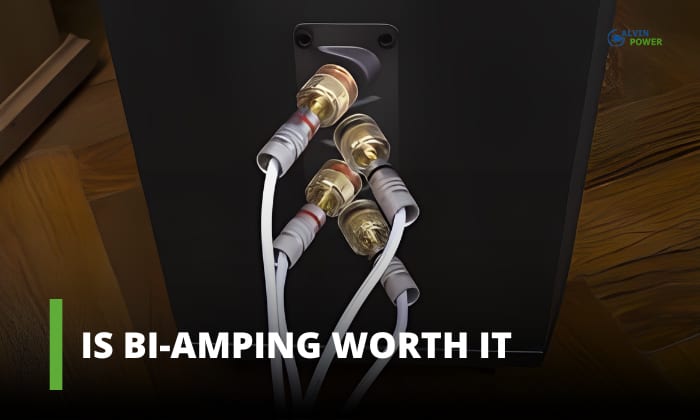Bi-amping refers to using two separate amplifiers to power the low and high-frequency drivers of a loudspeaker. Is bi-amping worth it? For the right audio systems, bi-amping can certainly be a worthwhile pursuit.
Bi-amping benefits have the potential to improve clarity, bass control, and overall audio performance. However, actual benefits depend on proper implementation and system synergy.
Table of Contents
How Much of a Difference Does Bi-amping Make?
1. How does bi-amping work?
Traditional amplification uses one amplifier to power all frequencies for a speaker. Bi-amping utilizes separate amplifiers for low and high frequencies, dedicating power to the unique demands of bass and treble.
Bi-amping requires speakers with two sets of binding posts to connect each amp. The internal crossover, which divides frequencies between drivers, remains in the speakers. This is known as passive bi-amping.
An alternative called active bi-amping removes the speaker crossover from the circuit. Each amp directly powers a driver, and there is a separate crossover in front of the amps. This allows more control but requires specialized equipment.
When I bi-amp in an active setup, for example, I’ve found that I can optimize sound quality. However, it won’t extend the frequency range downward – that usually requires me to bi-amp a subwoofer.
2. Benefits of Bi-Amping
- Improved bass – Woofers require abundant current and are therefore more power-hungry. The added power from bi-amping enhances the bass impact, extension, and control.
- Cleaner sound – More amplifier headroom can mean less distortion, especially at high volumes. Overall, the sound may be more open and transparent.
- Greater efficiency – Splitting the crossover results in less wasted power filtering frequencies. Each driver gets a tailored frequency range from its assigned amp.
However, this benefit is more pronounced in active bi-amping, where the crossover is placed before the amplifiers, rather than passive bi-amping, where the crossover is inside the speaker.
- Upgraded flexibility – Active bi-amping allows experimenting with on-hand amps of different classes or sounds to optimize different drivers.
- Better integration – Active bi-amping with optimized external crossovers can potentially improve driver cohesion and response. But this requires advanced crossover design skills to match the speaker.
However, benefits depend on implementation and system synergy. Not all users report significant differences, especially with moderate-cost gear.
3. Bi-Amping Setup and Configuration
You will need:
- Speakers with two sets of binding posts – One powers the bass drivers, the other the high frequency. Speakers with only one set of posts cannot be bi-amped.
- Amplification – A receiver or two stereo amps can work. The amplifiers should ideally be identical or from the same brand with (mostly) the exact same specs for passive bi-amping. Active bi-amping doesn’t require similar amplifiers.
- Speaker wires – Need two runs per channel. So bi-amping a stereo pair requires a total of 4 runs.
- Optional crossover – For active bi-amping, implement a crossover before each amp.
- For passive bi-amping, connect the bass amp to a speaker’s low-frequency post, and the high-frequency amp to another corresponding set of posts. Remove the jumpers between the speaker terminals.
Having bi-amp speakers with two amps of different classes can optimize sound. For example, use a tube amp for mids/highs and solid state for bass.
With one amplifier type, passive bi-amping can increase power and lower distortion. But sound improvement is minimal without distinct amps.
See the accompanying diagram demonstrating bi-amping setups. Note that bi-amping uses two channels of amplification, while bi-wiring speakers uses only one amplification channel.
Here’s a brief guide on how to bi-amp your speakers:
- First, ensure that your speakers are compatible with bi-amping. They should have two sets of connections, usually marked as high and low or bass and treble.
- Always ensure that your system is powered off before making any connections.
- Remove the jumpers or bridges that connect the two positive terminals and negative terminals on your speakers.
- Connect each amplifier to its respective speaker section. One amplifier should be connected to the woofer section of a loudspeaker while the other is connected to the combined mid and tweeter section.
- Carefully match the output levels of both amplifiers so that the high and low frequency drivers receive signals at equal volume. This typically involves adjusting the crossover settings.
- Bi-amping enables tailoring the system’s tonal balance by adjusting the relative levels of the bass and treble amplifiers to suit your listening preferences.
Conclusion
Is bi-amping worth it? Yes, bi-amping can be a worthwhile upgrade for the right systems. It enables greater amplification power and separates the demands of bass vs. treble reproduction. However, benefits are highly dependent on implementation and system synergy.
While cost-prohibitive for many users, bi-amping remains a worthwhile endeavor for audiophiles seeking to extract every ounce of performance from reference speakers and electronics.

I am Andrew Wright. With 8 years of experience designing, installing, and maintaining electrical power systems. I love my job, and I have always wanted to offer others the necessary help so they can take care of their houses.




